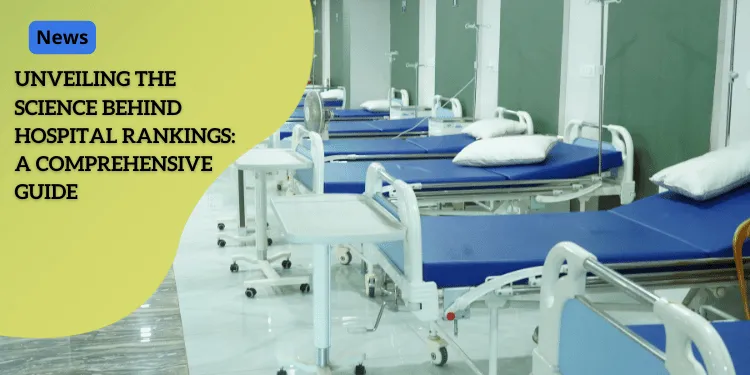Unveiling the Science Behind Hospital Rankings: A Comprehensive Guide

Anúncios
Overview of U.S. News Best Hospitals Rankings
The U.S. News Best Hospitals rankings are a trusted resource designed to help patients navigate the complex landscape of healthcare.
These rankings are divided into two main categories: specialty rankings and procedure/condition ratings.
Anúncios
It’s essential to understand these distinctions to make informed decisions about your healthcare.
Importance of Hospital Rankings for Patient Decision-Making
When faced with serious health concerns, choosing the right hospital can be critical.
Anúncios
Hospital rankings provide valuable insights into which hospitals excel in specific areas, helping patients and families find the best care for their needs.
By highlighting top performers in specialties and procedures, these rankings can reduce the stress and uncertainty of hospital selection.
Patients can make more confident decisions, knowing they are choosing from hospitals recognized for superior care in their specific medical needs.
Distinction Between Specialty Rankings and Procedure/Condition Ratings
Specialty rankings focus on hospitals equipped to handle complex, high-risk cases, such as life-threatening or rare conditions.
These rankings list the top 50 hospitals in each of the 15 specialties, such as cancer and cardiology.
Hospitals that don’t make the top 50 but are still in the top 10% receive a “high performing” label. In contrast, procedure and condition ratings evaluate everyday treatments like heart bypass surgery and hip replacement.
Rather than numerical ranks, these evaluations categorize hospitals as high performing, average, or below average, assessing how well they handle these common procedures.
Understanding these distinctions is crucial. For instance, if you need specialized treatment for a rare condition, looking at specialty rankings is more relevant.
Conversely, if you need a common procedure, checking the condition ratings will provide you better insights.
Next, we’ll delve into understanding specialty rankings and their particular focus on complex and high-risk medical cases.
Understanding Specialty Rankings
Purpose of Specialty Rankings for Complex and High-Risk Cases
Specialty rankings are essential for patients dealing with life-threatening or rare conditions that require specialized and advanced care.
These rankings focus on hospitals capable of handling complex, high-risk cases where the medical expertise and resources go beyond the standard medical facility.
List of 15 Specialties Evaluated
U.S. News Best Hospitals evaluates hospitals across 15 unique specialty areas to ensure comprehensive coverage of various complex medical needs.
These specialties include:
- Cancer
- Cardiology, Heart & Vascular Surgery
- Diabetes & Endocrinology
- Ear, Nose & Throat
- Gastroenterology & GI Surgery
- Geriatrics
- Obstetrics & Gynecology
- Neurology & Neurosurgery
- Orthopedics
- Pulmonology & Lung Surgery
- Rehabilitation
- Urology
- Ophthalmology
- Psychiatry
- Rheumatology
Methodology: Data-Driven vs. Expert Opinion-Based Rankings
The methodology behind these rankings can be categorized into two main approaches: data-driven and expert opinion-based.
Data-Driven Rankings
For 12 of the 15 specialties, rankings are determined through comprehensive data analysis.
These specialties rely heavily on quantifiable metrics, such as:
- Medicare data for performance and outcomes
- Patient safety indicators
- Nurse staffing levels
- Advanced technology availability
- Hospital reputation
Expert Opinion-Based Rankings
The other three specialties—Ophthalmology, Psychiatry, and Rheumatology—use a different approach.
Here, rankings are based entirely on expert opinions.
In these cases, U.S. News conducts surveys targeting physician specialists over three years, asking them to name hospitals they would refer their sickest patients to.
This methodology ensures that the subjective expertise of seasoned professionals is recognized and utilized.
Understanding how these rankings are compiled can help you make better-informed decisions when choosing a hospital for specialized care.
Though rankings are valuable, it’s crucial to consider other individual factors in your healthcare journey to ensure the best possible outcomes.
Procedure and Condition Ratings Explained
Focus on Common Procedures and Conditions
When it comes to hospital ratings, specialty rankings might grab headlines, but what about the more everyday medical procedures and conditions that many of us might face? That’s where the procedure and condition ratings come into play.
Unlike specialty rankings, which focus on complex and high-risk cases, these ratings assess how hospitals perform on common procedures and conditions like hip replacements, heart bypass surgery, and treating pneumonia.
Rating System: High Performing, Average, Below Average
These ratings help simplify a critical question: how good is a hospital at handling routine medical issues? Instead of a numerical ranking, hospitals are rated as “high performing,” “average,” or “below average” for each procedure or condition.
This straightforward approach aims to make it easier for patients to evaluate their options, especially when they need to make a quick decision about where to go for treatment.
List of 20 Procedures and Conditions Evaluated
To provide comprehensive evaluations, U.S. News assesses hospital performance across 20 commonly required procedures and conditions.
Here is the list:
- Abdominal aortic aneurysm repair
- Aortic valve surgery
- Back surgery (spinal fusion)
- Chronic obstructive pulmonary disease (COPD)
- Colon cancer surgery
- Congestive heart failure
- Diabetes
- Gynecological cancer surgery
- Heart attack
- Heart bypass surgery
- Hip fracture
- Hip replacement
- Kidney failure
- Knee replacement
- Leukemia, lymphoma, and myeloma
- Lung cancer surgery
- Pneumonia
- Prostate cancer surgery
- Stroke
- Transcatheter aortic valve replacement (TAVR)
These evaluations are designed to capture a broad range of medical needs, ensuring that the ratings can serve the majority of patients requiring hospitalization.
Understanding how hospitals perform on these common procedures can make a world of difference when choosing where to seek care.
While the ratings provide valuable insights, always remember to discuss these options with your healthcare provider.
This holistic approach ensures that you’re considering all factors, from hospital performance to insurance coverage and proximity.
Data Collection and Evaluation Process
Sources of Data For Rankings and Ratings
The credibility of the U.S. News Best Hospitals rankings hinges on where the data comes from.
The rankings rely heavily on robust, multi-source data to ensure accuracy and reliability.
The primary sources include Medicare data, clinical outcomes, structural elements like hospital volume and nurse staffing, and patient experience metrics.
These elements are thoroughly evaluated to offer a comprehensive assessment of hospital performance across various specialties and procedures.
Role of Medicare Data in Evaluations
A significant portion of the data used in the hospital rankings is derived from Medicare records.
This includes information on patient outcomes, mortality rates, readmission rates, and other critical performance indicators.
Medicare data helps to objectively evaluate the quality of care provided, especially since it covers a large and diverse patient demographic.
This makes it a vital component in determining how hospitals stack up against each other, particularly in handling complex and high-risk cases.
Importance of Physician Surveys in Certain Specialties
While data-driven metrics are fundamental, the insights gathered from physician surveys are equally invaluable for certain specialties.
For fields like Ophthalmology, Psychiatry, and Rheumatology, expert opinions are crucial. U.S. News conducts surveys where specialist physicians are asked to rank hospitals based on where they would refer their sickest patients.
These expert opinions complement the hard data, ensuring that the rankings reflect both quantitative outcomes and qualitative expert judgments.
Understanding the sources and evaluation methods empowers patients to make informed decisions, leveraging comprehensive data and expert insights to select the right care facility.
This depth of evaluation underscores the reliability of the rankings, offering a nuanced perspective on hospital performance.
Interpreting Rankings and Ratings
Understanding how to use hospital rankings and ratings can be crucial in making informed healthcare decisions.
While the U.S. News Best Hospitals rankings provide a wealth of information, evaluating these metrics can sometimes be overwhelming.
This section will guide you on how to interpret these rankings effectively.
How to Use Rankings and Ratings in Healthcare Decisions
Start by identifying the medical condition or procedure for which you need care.
The U.S. News Best Hospitals rankings differentiate between specialty rankings and procedure and condition ratings, each serving a distinct purpose. Specialty rankings are more relevant for complex, high-risk cases and specialty care, like cancer or neurosurgery.
Conversely, procedure and condition ratings focus on more common treatments, such as hip replacements or pneumonia management.
When choosing a hospital, look for those rated as “high performing” in the relevant specialty or condition.
A “high performing” label indicates that the hospital is among the top in providing effective and safe care.
Considerations Beyond Rankings
While rankings are a useful starting point, other factors should also influence your decision.
Location is a significant consideration, as proximity can make frequent visits more manageable.
Additionally, check if the hospital is within your insurance network to minimize out-of-pocket costs.
Assessing patient reviews and consulting with your doctor can provide valuable insights.
When possible, visit the hospital to observe its environment and interact with staff. Sometimes, an “average” hospital nearby might be more convenient and personalized than a “high performing” one far away.
Importance of Consulting with Medical Professionals
Ultimately, while rankings offer quantifiable data, healthcare decisions should always involve medical professionals.
Discuss the U.S. News rankings with your doctor to understand what they mean for your specific condition.
Healthcare providers can provide nuanced advice tailored to your needs, considering factors that rankings might overlook.
Balancing rankings with professional medical advice and personal considerations ensures a comprehensive approach to selecting the best hospital for your needs.
Impact and Limitations of Hospital Rankings
Benefits of Rankings for Patients with Complex Medical Needs
Hospital rankings, such as the U.S. News Best Hospitals, provide invaluable guidance for patients facing complex and high-risk medical decisions.
For individuals needing specialized or high-stakes care, knowing which hospitals excel in particular areas can significantly impact outcomes.
These rankings empower patients with data, ensuring that they can seek care from top-performing institutions known for handling intricate cases.
The specialty rankings and procedure/condition ratings act as a compass, pointing patients toward hospitals capable of providing the highest level of care.
Potential Limitations and Considerations When Using Rankings
While hospital rankings are undoubtedly useful, they come with limitations.
One significant downside is that not all hospitals participate in the survey, potentially skewing results.
Additionally, rankings don’t always consider factors like geographic location or patient preference, which can be crucial.
For example, a high-ranking hospital might be out of state or outside a patient’s insurance network, making it impractical despite its stellar performance.
Patients should also remember that these rankings should be a starting point.
Consultation with healthcare providers is essential to factoring in personalized care needs.
Evolution of Ranking Methodologies Over Time
Like any measure striving to stay relevant and accurate, the methodologies behind hospital rankings have evolved.
Originally, rankings were heavily reliant on data, such as mortality rates and patient outcomes from Medicare.
Over time, the incorporation of physician surveys and expert opinions—particularly in specialties like Ophthalmology and Psychiatry—has added a qualitative dimension to the rankings.
As medical practices, technologies, and data collection methods advance, ranking methodologies continue to adapt, striving to provide the most accurate and comprehensive assessments possible.
By offering a blend of quantitative data and expert evaluations, these rankings aim to guide patients toward informed healthcare choices, constantly refining their methods to keep pace with the evolving medical landscape.






